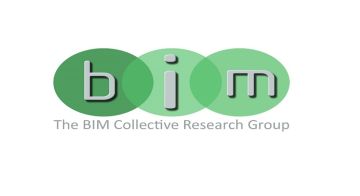
The BIM Collective Research Group was formed in February 2013. The principle aims of the group are:
• Industry -Academia Partnerships
• European & UK 3rd level education collaboration
• Professional / Academic collaboration
• Collaborative projects within SETU Waterford Programmes & Research Groups
• Personal research paths
From the outset The BIM Collective (BIMC) has utilised the Enterprise Ireland Innovation Voucher programme to fund Industry -Academia Partnership projects. These have covered a broad range of companies many of whom are involved in or seeking competitive advantages in tendering projects in the UK and farther afield; these include projects in Saudi Arabia, Estonia & the UK.
In conjunction with research through industry – academia partnerships, the BIMC have developed links with European & UK 3rd level colleges & universities through the International Congress of Architectural technologists (ICAT) and Chartered Institute of Architectural Technologists (CIAT). Discussions are at an early stage in developing joint projects through Horizon 2020. Exploratory visits to potential partners are planned for the coming year. It is essential to internationalise the research and draw from partner countries their experiences in implementing and working with a BIM methodology. This can then feed into our own industry – academia partnerships strengthening the knowledge of both students and the AEC partners.
The BIMC through the School of Engineering at SETU Waterford are initiating both an Approved Autodesk Training centre at SETU Waterford and a BIM / Revit Users Group for the south east where AEC professionals, students & staff can share & broaden a collective knowledge base. This would strengthen the symbiotic relationship through industrial placement, collaborative projects and student presentations to industry, ultimately leading to a stronger BIM ready AEC industry and graduate employment
The professional landscape of the Architectural, Engineering & Construction (AEC) sector is ever evolving, never has this been more evident than in recent years. The AEC industry is moving towards an integrated approach of “project delivery” between the relevant professionals, i.e. engineers, quantity surveyors, architectural professions and contractors. This is commonly referred to as a BIM (Building Information Modelling) methodology.
Many professionals in the AEC sector know about BIM, they know it is coming and they see the impact not being BIM ready is starting to have on their companies. This has grown ever more stark as the Irish AEC sector bids for projects overseas where a BIM methodology, if not mandatory may well be the deciding factor in contracts being awarded.
“The current buzzword for the construction industry at present, BIM may seem like another passing fad. The catch, however, is that it is here to stay.
"BIM is the next evolutionary phase within our profession and it is a logical one, just as moving from drawing boards to computers was a natural progression before.” (CIAT, 2013)
In the UK, by 2016 all Government related projects must utilise a BIM methodology. The Irish government is expected to follow suit in the coming years. Already, anecdotal feedback from AEC practices has highlighted the disadvantages they have encountered by not being equipped with the necessary skillset to successfully bid for State contracts. In the UK, by 2016 all Government related projects must utilise a BIM methodology. The Irish government is expected to follow suit in the coming years. Already, anecdotal feedback from AEC practices has highlighted the disadvantages they have encountered by not being equipped with the necessary skillset to successfully bid for State contracts.
Within the School of Engineering at SETU Waterford, there has always been a strong ethos of working closely with the AEC industry with industrial placement embedded in many of the schools programmes. In 2001 Dr. Ken Thomas, Head of the School of Engineering, was a founding member of the Construction IT Alliance who’s mission statement
“To actively encourage the Irish Construction sector to take full advantage of current and emerging Information and Communications Technologies” clearly heralded the BIM landscape we see today.
Within the Dept. of Architecture SETU Waterford has been teaching Revit, a BIM authoring tool since 2007, and fully integrated this into our programmes in 2010 when we ceased teaching traditional CAD and started introducing a BIM methodology. This has developed to a degree that The Architectural Technology Programme has been reshaped to reflect the new paradigm and will be launched soon as the” B.Sc. (Hons) in Architectural & BIM Technology”.
The key personnel behind the new programme identified that the AEC sector companies the graduates would be seeking employment from required up skilling in BIM and also that the AEC sector was at the forefront of the practical implementation of BIM.
It soon became clear that a strong industry -academia partnership would create a symbiotic relationship that would be of benefit to both parties, the students learning from industry and vice versa.
Ecopower Ltd, based in Kilkenny is involved in the design and the planning process of both small and large-scale wind farms in Ireland. Ecopower have found that selling a new project concept to a customer requires excellent visualisation of the proposed course at an early stage, which in turn requires significant investment in the initial proposal phase. While their design team has excellent 2D drafting skills, the process they currently use for developing topographic visualisations is very time-consuming.

- Image Proposed Wind Farm Project (3Ds Studio Max Design)
On complex projects Ecopower sometimes need to contract out 3D and topographical design to third parties, which adds significantly to the lead time and cost of project proposals. This led Ecopower to work with the BIM Collective Research group, Dept. of Architecture at WIT to work with their designers on a current project in order to allow Ecopower to contrast and compare their approach to 3D topographic modelling. The objectives were to produce from a single model a set of presentation images, a fly through animation, general arrangement plans with schedules (concrete volumes etc.) and cross and longitudinal sections.
The BIM Collective Research Group incorporated GIS data from a variety of commercial and public sources to generate digital surface models and digital terrain models. The objectives were successfully carried out by initially importing the provided AutoCAD drawings into Revit which were used as a reference for creating the 3D digital terrain.

- Image Proposed Wind Farm Project (Revit)
The generated building information model was used to create the general arrangement plans and sections with appropriate schedules. The model was then imported into 3Ds Studio Max Design to create excellent quality presentation images and several animations. 3Ds Studio Max Design allows for ambitious animations and incorporates a feature called “Civil View” which enables modelling and texturing of large scale projects such as Wind Farms.
The research carried out by the BIMC has allowed Ecopower to contrast and compare the research group’s approach to 3D topographic modelling. This has provided a very practical means of preparing Ecopower’s design team to use geospatial data in future projects.
NorDan UK has been supplying high performance windows and doors to the UK construction industry since 1981 and has grown to an industry leading position during this time. A wide range of external windows and doors produced from timber with optional aluminium-cladding is available from the NTech 0.7, NTech 0.8 and NTech 1.2 ranges providing exceptional energy saving as standard.
NorDan UK are at an early stage of adding value to its range of products and has begun to investigate ways in which Information Models may be used to improve the quality of information provided to BIM authors and designers. To retain and improve their market position they needed to be able to model window frame materials, insulation and glass types along with the characteristics of the building framework. This led NorDan UK to work with the BIM Collective Research group, Dept. of Architecture at WIT to develop Building Information Models of a range of new aluminium clad timber frame products that are being brought to market in 2015. This included several types of window and door families and glazed screen products.
The BIMC developed models for a new system NTech 0.8 and created four styles of windows and three styles of door families including a sliding door for this new range. The NTech 0.8 model was then further developed to create a bespoke glazed screen, which was also adapted for use with the existing NTech 1.2 system.
The glazed screen can be altered in many different design options as there is a choice of both openable and fixed windows within the system. This makes the glazed screen a fully customisable object which can be used as both a glazed screen system or for bespoke windows.
Drawings of the products in development were provided by NorDan UK in AutoCAD files. The AutoCAD drawings were imported into Revit and used as reference drawings to create the Revit families. All the Revit families were developed and referenced in line with the NBS BIM Object Standard which included the use of NBS, IFC and COBie parameters
One of the first projects the BIMC undertook was to ghost a traditional design & build project in Clonmel Ireland. The success of this project resulted in one student being employed by the contractor to champion BIM in their company. This project was presented at the recent CITA BIM Gathering in Dublin and the paper “Collaborative BIM Learning via an Academia-Industry Partnership” is to be published in the peer reviewed International Journal of 3-D Modelling.







